QuickBooks Desktop For WHMCS
Contents |
About QuickBooks Desktop For WHMCS
| QuickBooks Desktop For WHMCS module allows integration between the two systems and helps you improve your accounting management. This module synchronizes the clients, invoices and transactions details gathered in your WHMCS with QuickBooks database. |
- Module Features:
| ✔ Export Manually: |
| ✔ Clients |
| ✔ Invoices And Transactions |
| ✔ Products |
| ✔ Export Automatically: |
| ✔ Clients |
| ✔ Invoices |
| ✔ Transactions |
| ✔ Products |
| ✔ Invoices Refunds |
| ✔ Invoices Merge |
| ✔ Import Synchronization: |
| ✔ Clients |
| ✔ Invoices |
| ✔ Transactions |
| ✔ Products |
| ✔ Manage Relations: |
| ✔ Clients With Automatching |
| ✔ Custom Client Field |
| ✔ Products With Automatching |
| ✔ Invoices With Automatching |
| ✔ Tax Rules |
| ✔ Currencies With Payment Deposits |
| ✔ Define Default Product Item |
| ✔ Define Default Domain Item |
| ✔ Define Default Account For Products |
| ✔ Define Tax Zero-Rated |
| ✔ Define Home Currency |
| ✔ Define Automatic Export Settings |
| ✔ View Export And Cron Run Summary |
| ✔ View Web Connector Task |
| ✔ View Logs |
| ✔ Set Web Connector Account |
- General Info:
| ✔ Multi-Currency Support |
| ✔ Refunds Support |
| ✔ Multi-Language Support |
| ✔ Supports PHP 5.4 Up To PHP 7 |
| ✔ Supports WHMCS V6 and V7 |
- Requirements:
| ✔ QuickBooks Desktop Account |
| ✔ QuickBooks Web Connector |
| ✔ WHMCS With HTTPS and SSL Certificate |
Installation
| This tutorial will show you how to successfully install and configure QuickBooks Desktop For WHMCS. We will guide you step by step through the whole installation and configuration process. |
| 1. Log in to your client area and download the module. |
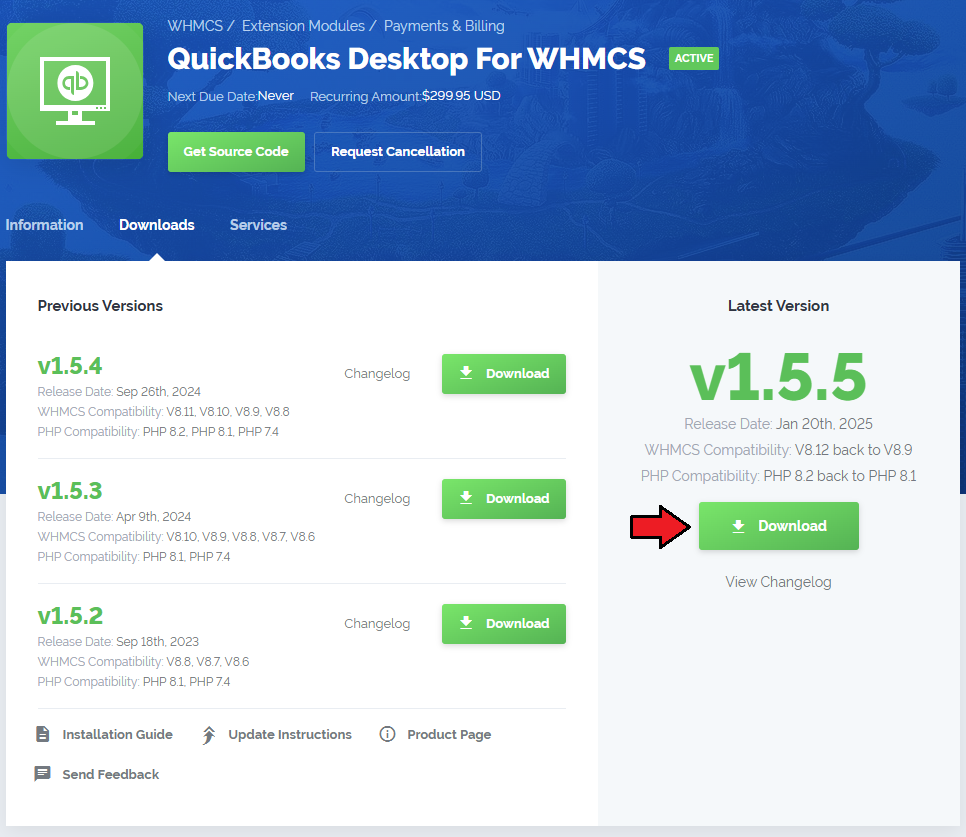
|
| 2. In the downloaded file you will find two packages that support different PHP versions. As presented on the screen below, the first one is dedicated to PHP 7, while the second one is aimed at PHP 5.4 up to PHP 5.6. It does not apply to open source versions. Note: You can check current PHP version in your WHMCS. To do so proceed to 'Utilities' → 'System' → 'PHP Info'. |

|
| 3. Extract the downloaded file and choose the one with the right PHP version. Upload and extract the PHP file into the main WHMCS directory. The content of PHP version files should look like this. |
| 4. When you install QuickBooks Desktop For WHMCS for the first time you have to rename 'license_RENAME.php' file. File is located in 'modules/addons/QuickBooks_Desktop/license_RENAME.php'. Rename it from 'license_RENAME.php' to 'license.php'. |
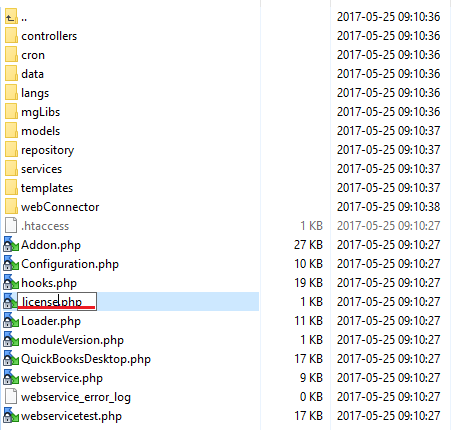
|
| 5. In order to configure your license key, you have to edit the previously renamed 'license.php' file. Enter your license key between quotation marks as presented on the following screen. You can find your license key in your client area → 'My Products'. |

|
| 6. Now you have to activate the module in your WHMCS system. Log in to your WHMCS admin area. Go to 'Setup' → 'Addon Modules' . Afterwards, find 'QuickBooks Desktop' and press 'Activate' button. |
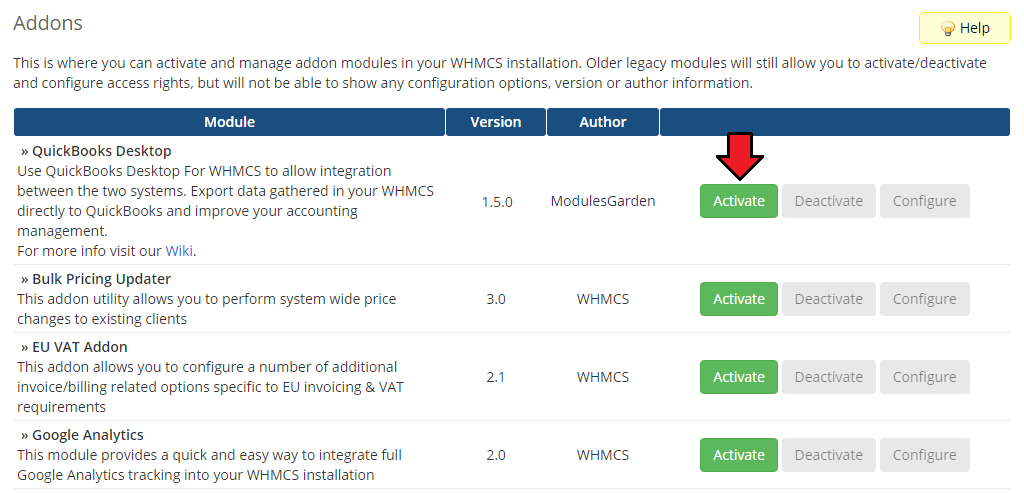
|
| 7. In the next step you need to permit access to this module. To do so, click on 'Configure' button, check required group of administrators and press 'Save Changes'. |
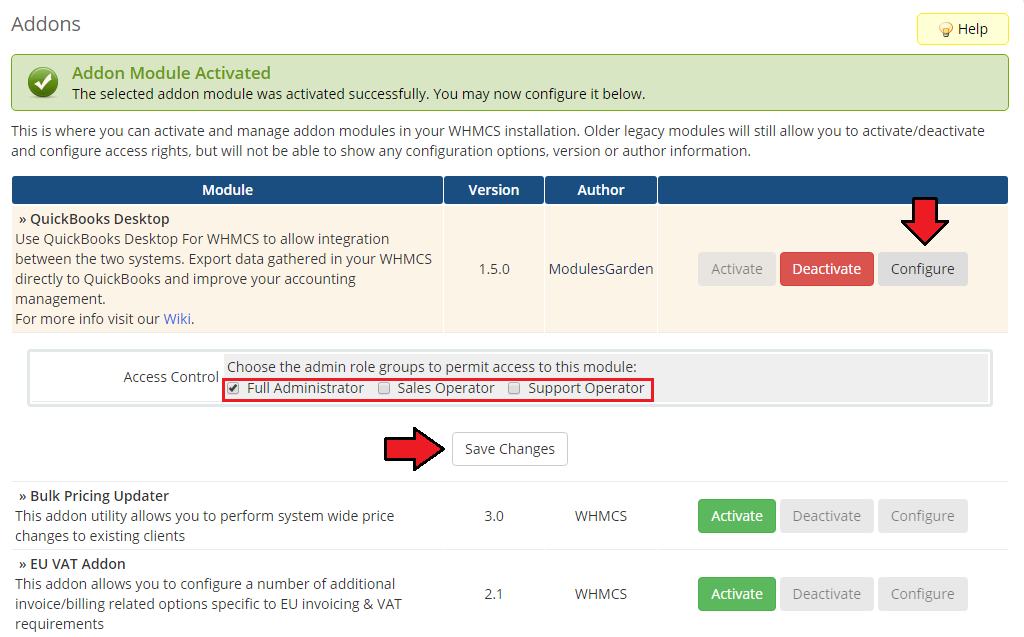
|
| 8. You have just successfully installed QuickBooks Desktop For WHMCS! You can access your module under 'Addons' → 'QuickBooks Desktop'. |
Configuration and Management
| QuickBooks Desktop For WHMCS is a module which allows you to export any data on clients, invoices and transactions directly to QuickBooks Desktop. |
Configuration
| 1. To configure your module properly, first you have to add new account. To do so proceed to 'Addons' → 'QuickBooks Desktop' → 'Settings' → 'Accounts'. |
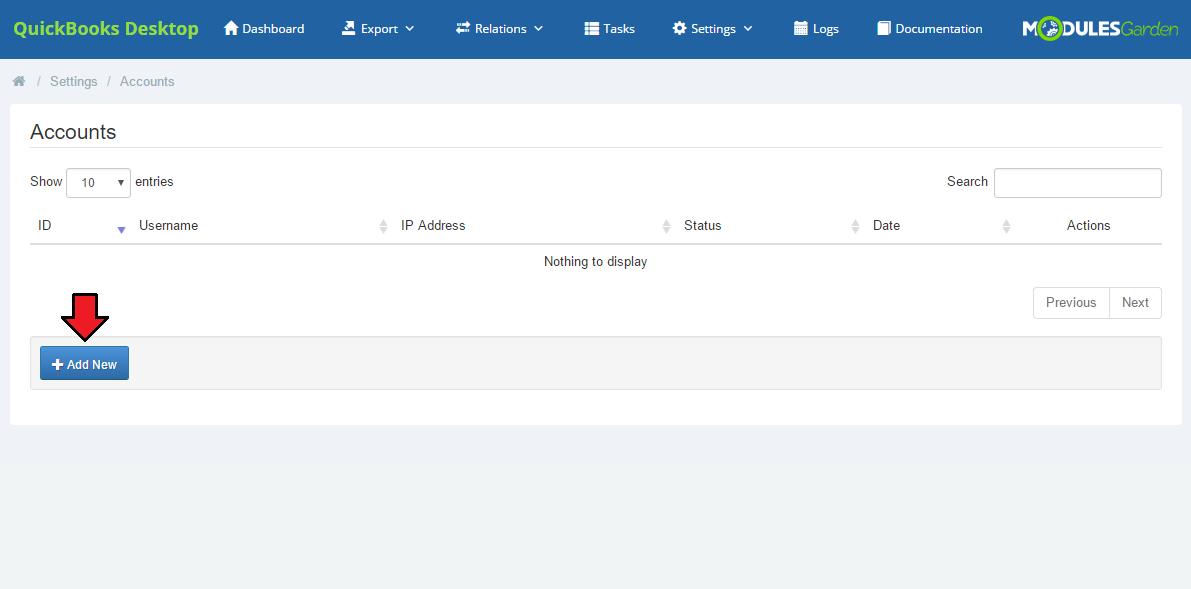
|
| In order to use the module fully, your account will be linked to Web Connector, a tool allowing integration beetween your WHMCS system and QuickBooks Desktop. Provide the necessary information. You can also define when the data will be synchronized automatically. |
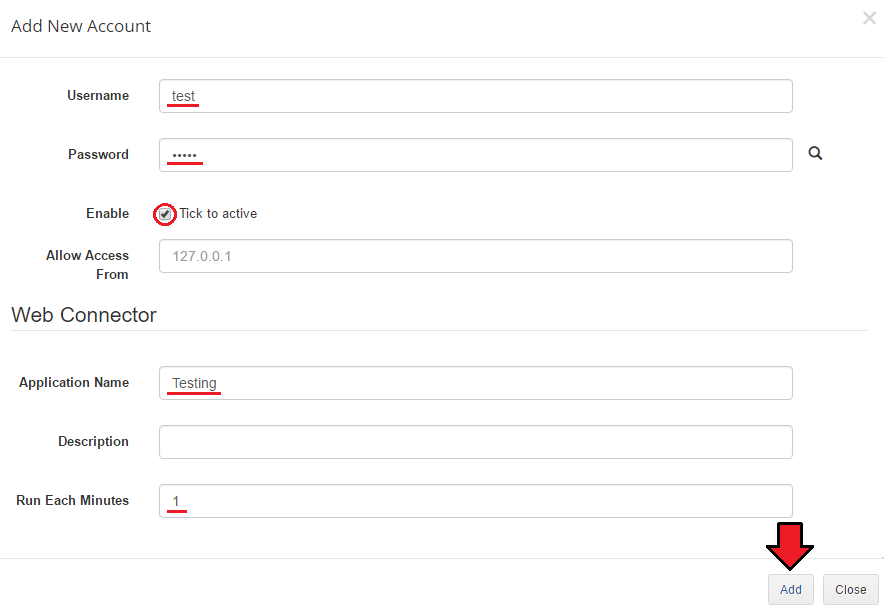
|
| Your account should appear on the list. It can be switched on/off, edited or deleted. For the proper configuration, you need to download the file for Web Connector now, as shown below. |
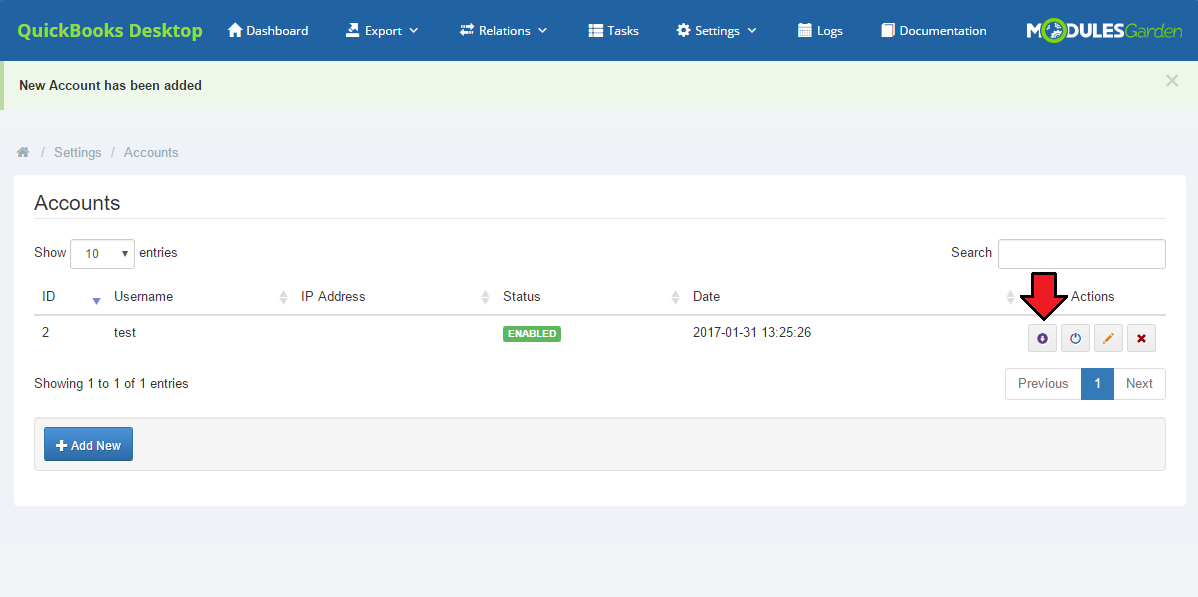
|
| Be sure that your QuickBooks Desktop software is now running and has opened your company file. |
| Then open the generated account file in the QuickBooks Web Connector. Click 'OK'. It will allow the module to authenticate your identity in QuickBooks system and let connect your WHMCS with it. |
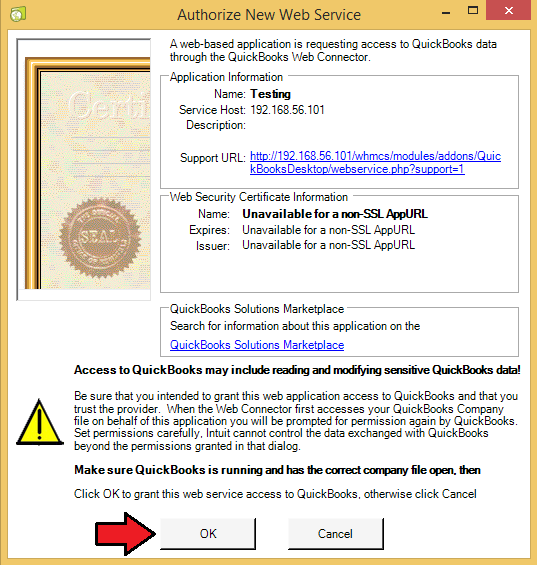
|
| Next, the certification window will appear to ask for permission to read and modify your company file. Choose the appropriate option and continue. |
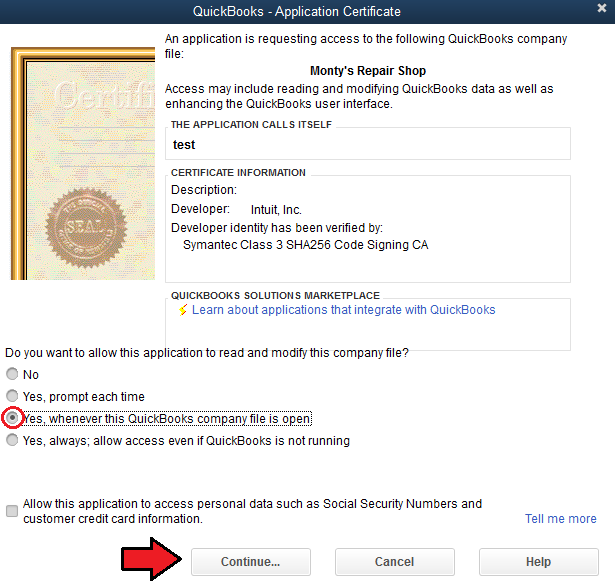
|
| You should see successfully added account in Web Connector window: |
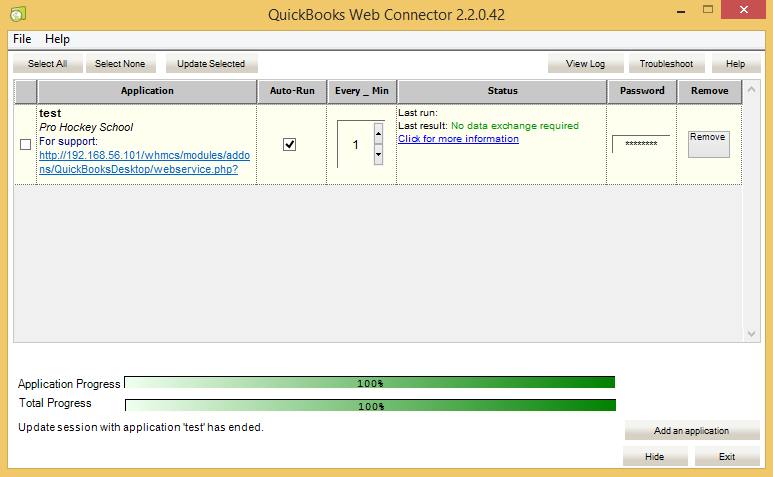
|
| 2. Synchronization Settings - decide which of the possible synchronization options you want to enable. Proceed to 'Addons' → 'QuickBooks Desktop' → 'Settings' → 'General' and tick the ones you are interested in. |
| In 'Task' tab you can check whether all the tasks are completed. Only then the values will be visible. |
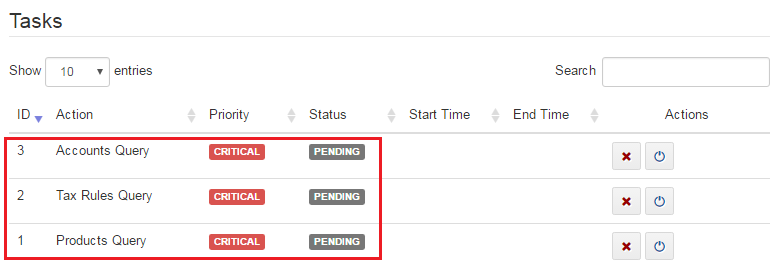
|
| The following synchronization options are available: Clients synchronization:
Invoices synchronization:
Payments synchronization:
Refunds synchronization:
Products synchronization:
Query synchronization:
|
| For more information about Import Synchronization configuration go to the Cron Jobs section. Apart from choosing required synchronization options, you have to decide here, which items from QuickBooks Desktop, 'Products ' and 'Domains' will be associated with.
Press Save Changes button. |
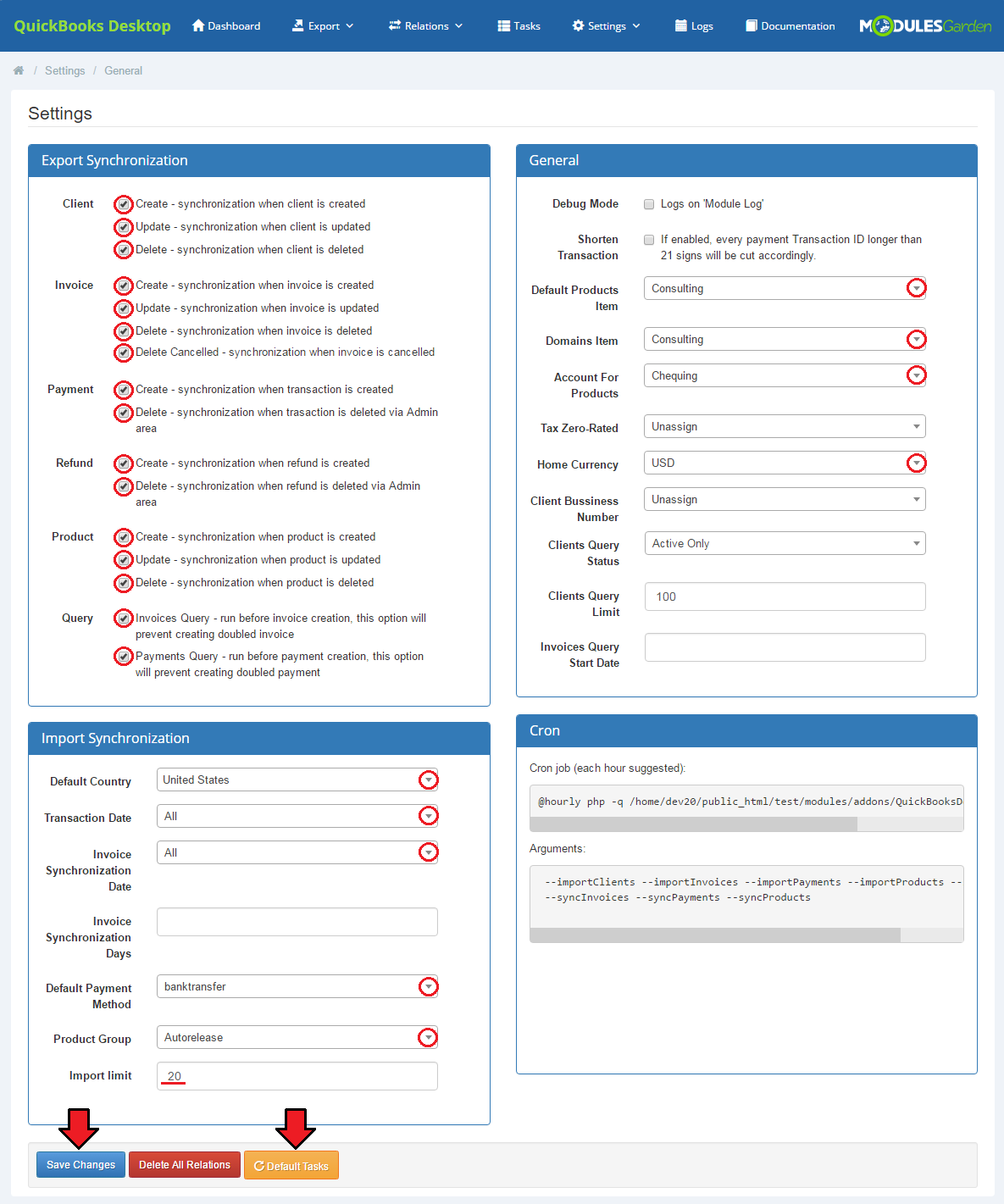
|
| All the tasks and their statuses will be displayed in Task tab. |
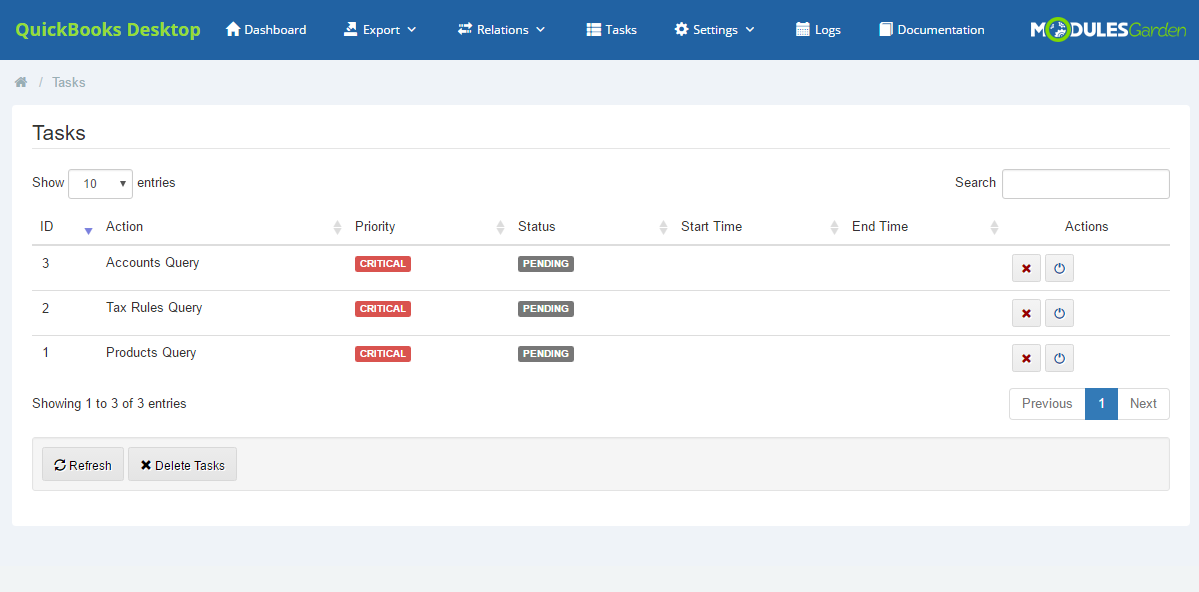
|
| 3. To use the module properly, remember to set the relations correctly. It is possible to manually declare relations between WHMCS clients, products as well as invoices and corresponding to them QuickBooks Desktop elements. |
Relation: Tax Rules
| In 'Relation' → 'Tax Rules' directory, you will find a list of defined taxes rules. Firstly, select 'Tax Rules Query' option and wait until all tasks are done. Then assign each rule to a specific QuickBooks tax. Select one from a dropdown menu and save changes. |
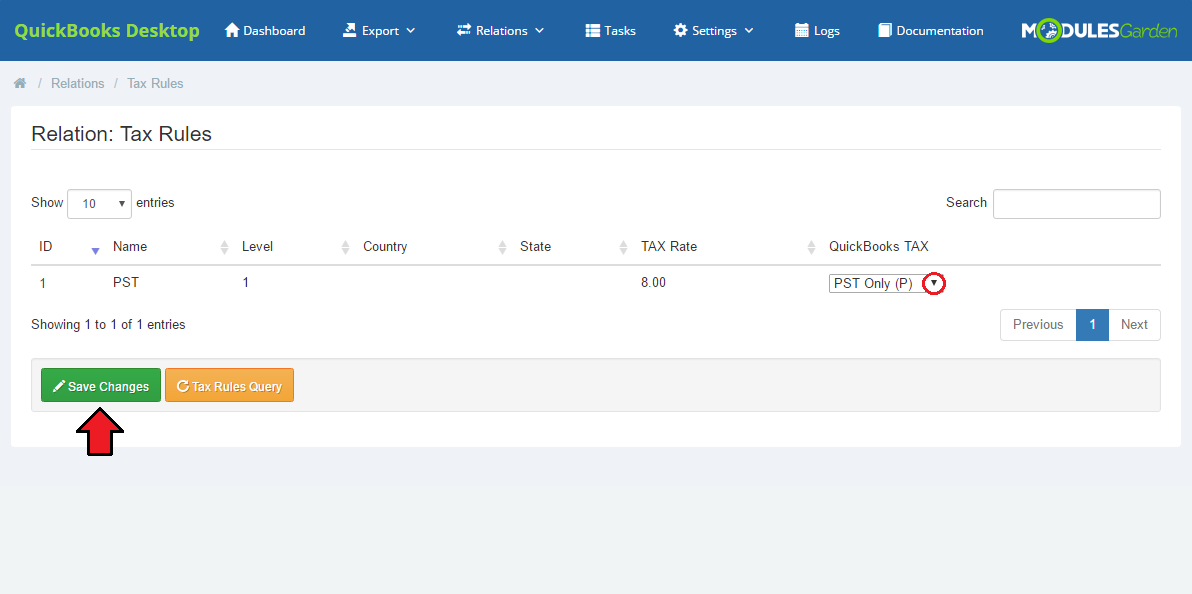
|
Relation: Currencies
| In 'Relation' → 'Currencies' directory, you will find a list of defined currencies. Firstly, select 'Currencies Query' option and wait until all tasks are done. Then assign each currency to a specific one from QuickBooks Desktop. Select one from a dropdown menu and save changes. Note that if you would like to use several currencies, 'Multicurrency' option must be enabled in QuickBooks Desktop settings. Otherwise the process will not be successful. |
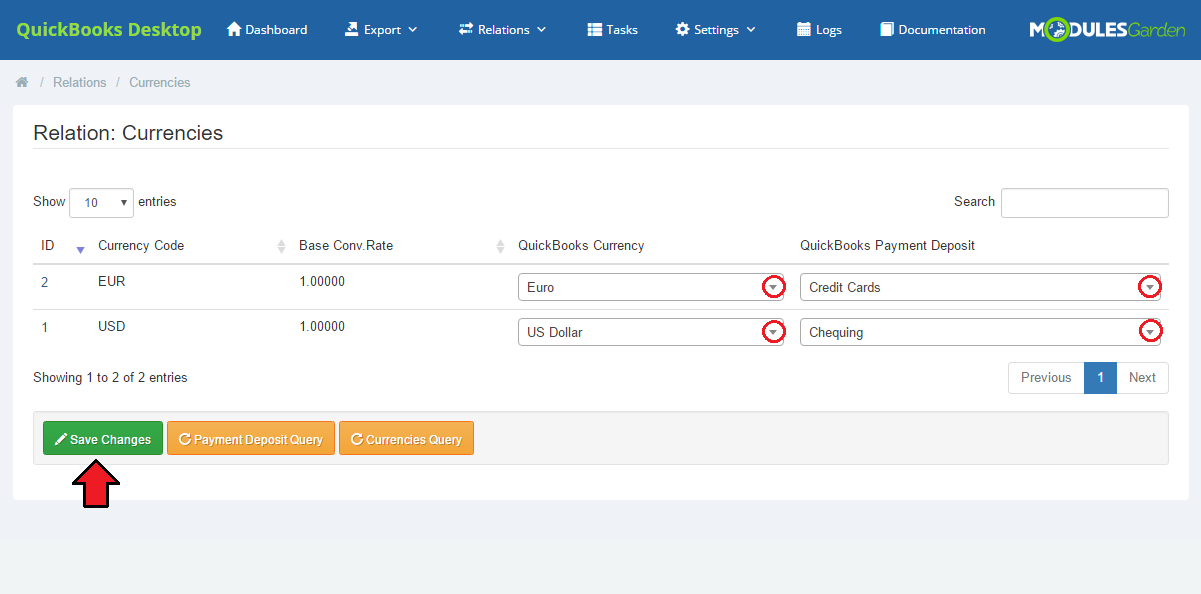
|
Relation: Custom Client Fields
| When you go to 'Relation' → Custom Client Fields' , you will find a list of fields which appear in the client profile. Firstly, select 'Clients Query' option and wait until all tasks are done. Note that if all clients in QuickBooks Desktop have the same custom field with no value provided, that field will not be synchronized and displayed on the list. At least one of the clients must have it filled in. |
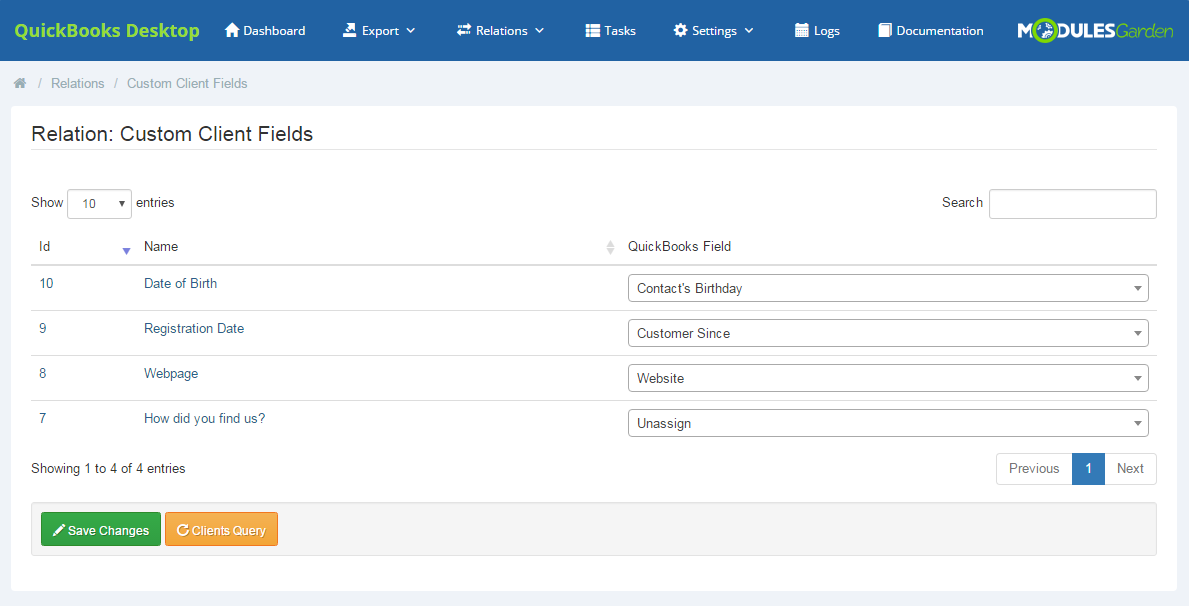
|
Management
| At this section we will show you the possibilities of QuickBooks Desktop For WHMCS. Once it has been properly connected with QuickBooks Desktop and all the configuration is now ready, we can move on to 'Export' section. |
Export
| Our module allows several ways to export any data gathered in your WHMCS. Read the below points to learn what data can be synchronized with QuickBooks Desktop and what are the possible means of such synchronizations. |
Clients
| The first option offered by our module is the export of clients from WHMCS to QuickBooks Desktop, proceed to 'Export' → 'Clients.' You will see here a list of all clients who exist in your WHMCS and have not been synchronized with QuickBooks yet. Use filter to find clients with their account created during the specified period of time. |
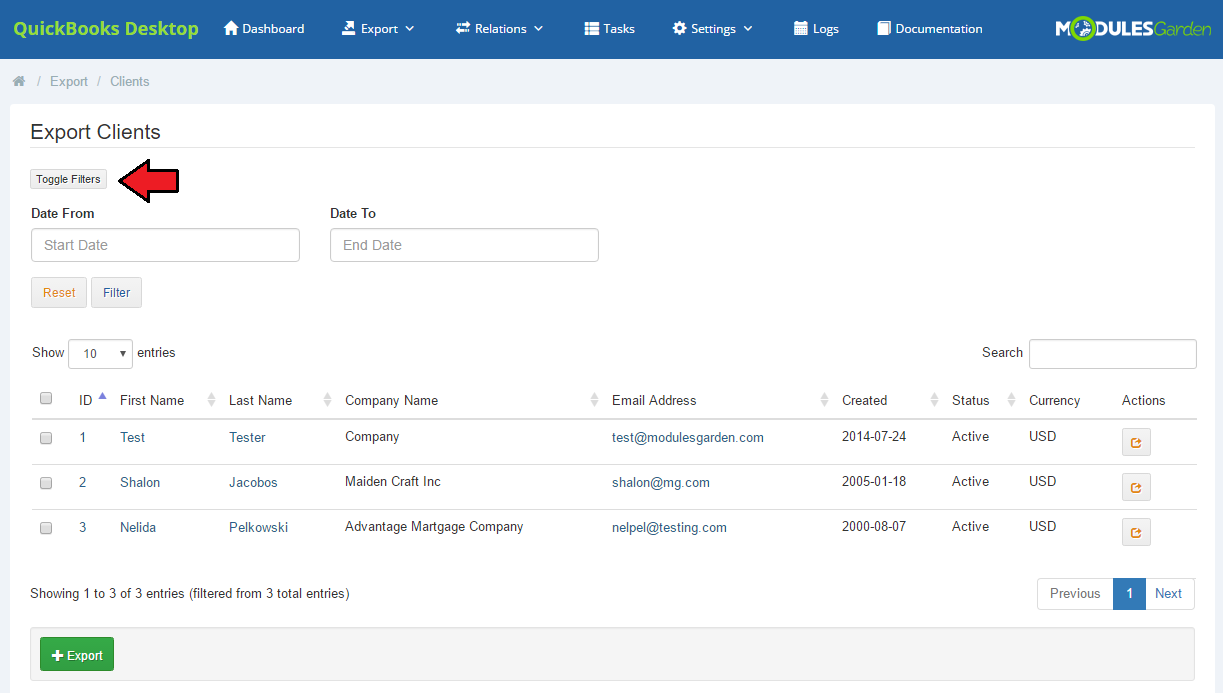
|
| Now, you can manually export all of the clients available on the list or choose only some of them. Check boxes next to the clients you are going to export and press 'Export' button as marked on the screen. If you want to export only one client you can do it by pressing 'Export' button located in 'Action' column next to the name of the client. |
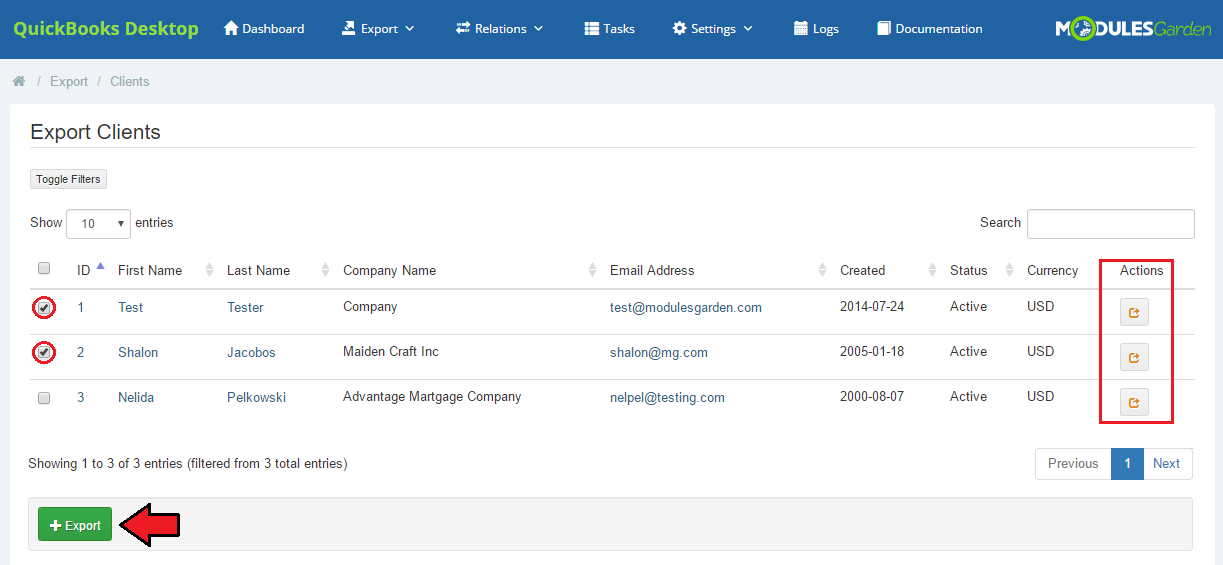
|
| If a client has already been exported from WHMCS to QuickBooks, they will no longer be visible on the list. All clients newly added to WHMCS will be automatically synchronized with QuickBooks unless otherwise stated in 'Synchronization Settings.' |
Invoices
| The other choice is the export of invoices. Proceed to 'Export' → 'Invoices' and you will find a list of all invoices existing in our WHMCS that have not been synchronized with QuickBooks yet. In details you will find information on the invoice:
|
Just like in case of clients:
|
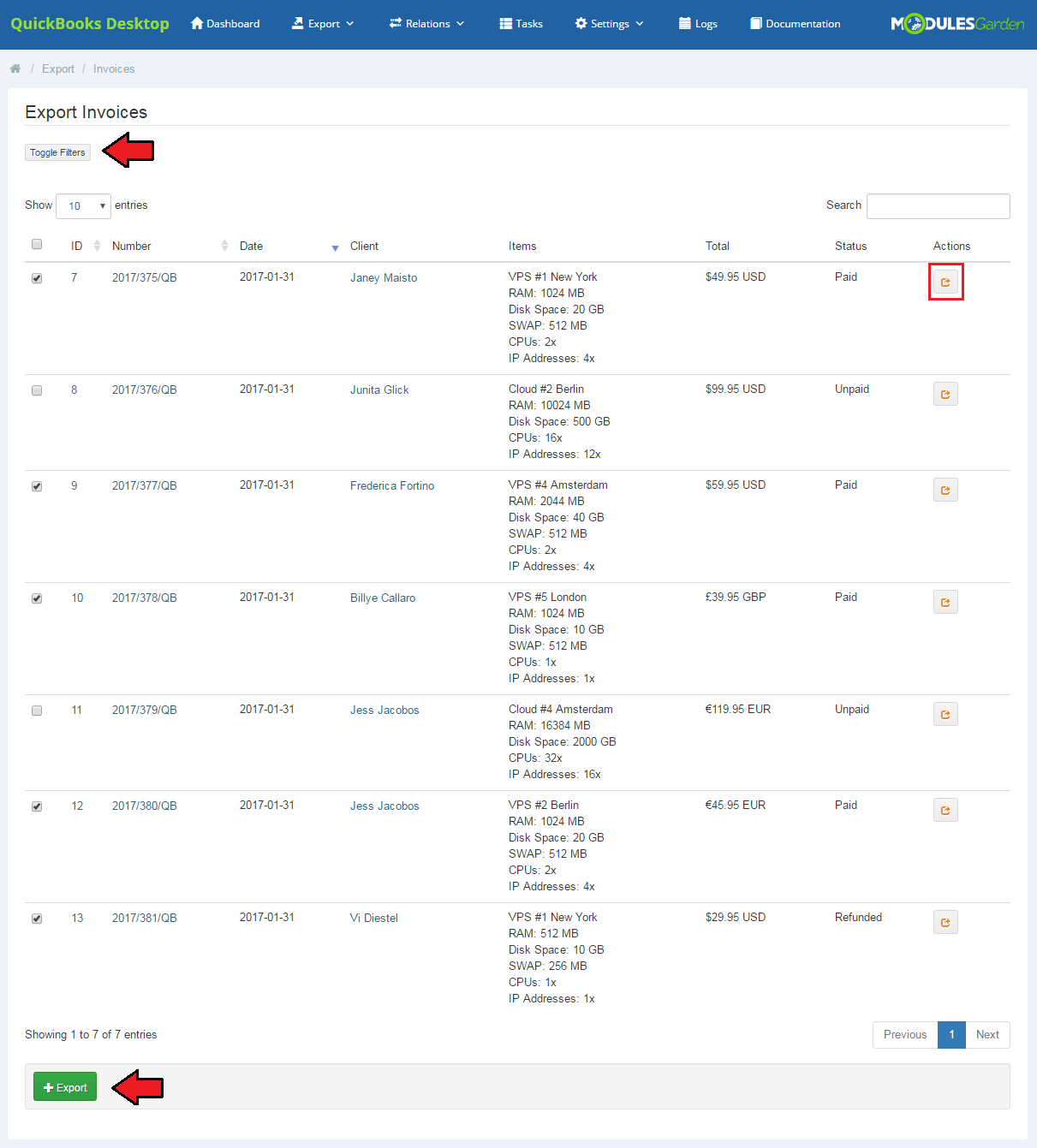
|
| Once you have exported some of the invoices you will see their number along with the number of any transactions connected with them in 'Summary' table on the dashboard. |
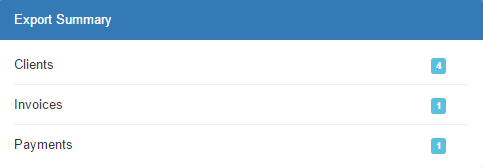
|
| Keep in mind that all newly added (after the first usage of QuickBooks For WHMCS) invoices and transactions are automatically synchronized and exported to QuickBooks Desktop unless otherwise stated in 'Synchronization Settings.' |
Relation: Clients
| Another possible relations to be declared are relations between WHMCS clients and QuickBooks customers. Proceed to 'Relation' → 'Clients,' you will find there a list of all clients, with their email addresses, that exist in WHMCS, |
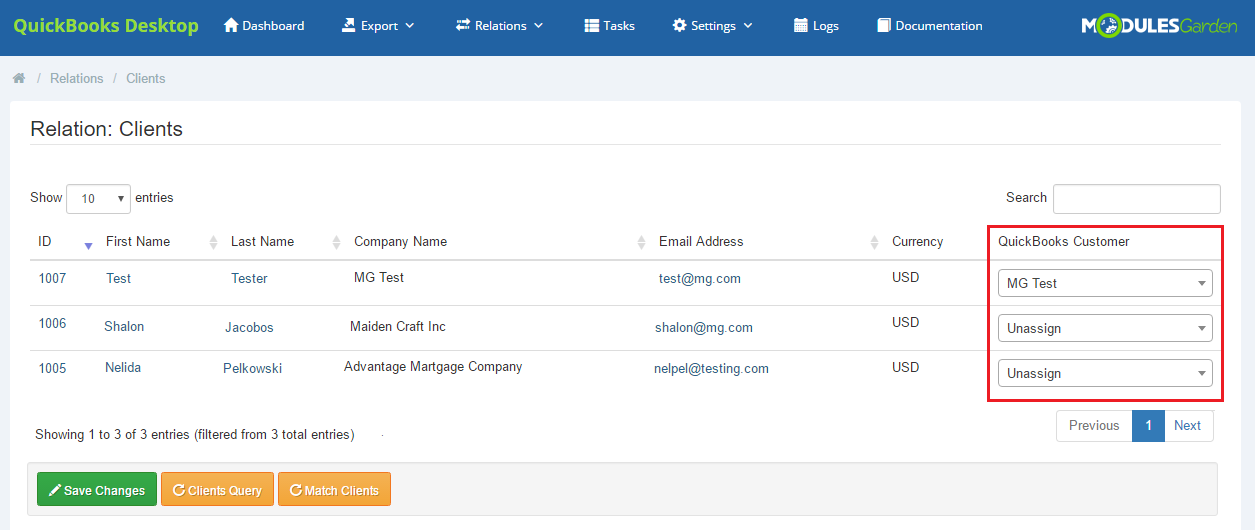
|
Relation: Products
| Products relations can be declared manually and for each product separately along with those declared in 'Configuration' → 'Synchronization Settings.' ' Proceed to 'Relation' → 'Products,' you will find there a list of all products with their type and payment standard. |
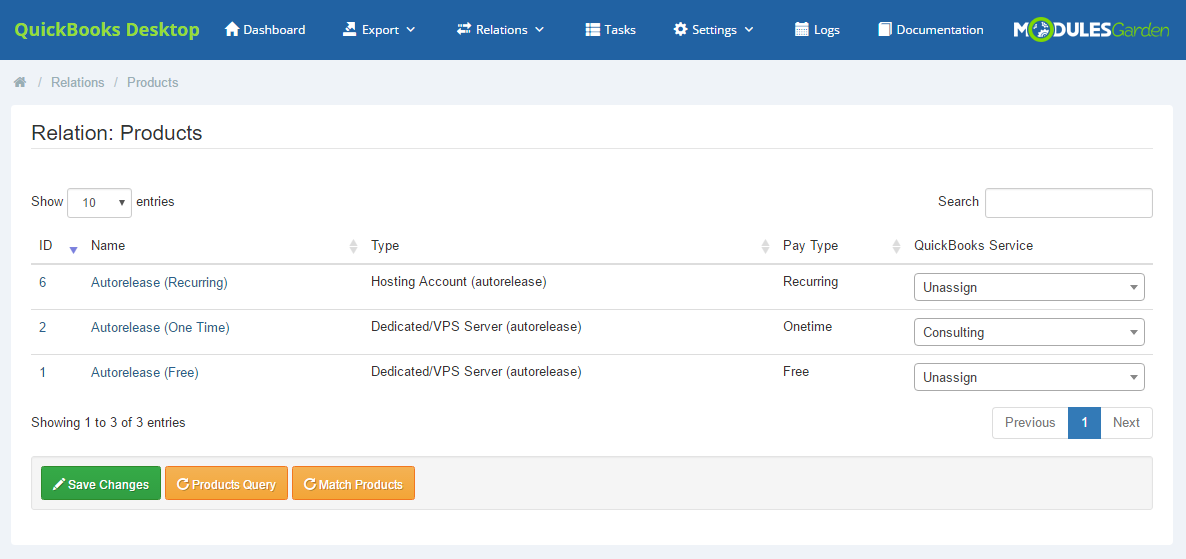
|
Relation: Invoices
| In 'Relation' → 'Invoices' directory, you will find a list of all WHMCS invoices with their ID, date of creation, assigned client, total sum on it and status. It is possible to assign such WHMCS invoice to another invoice already exported to QuickBooks Desktop. Just choose such from dropdown menu and save changes. |
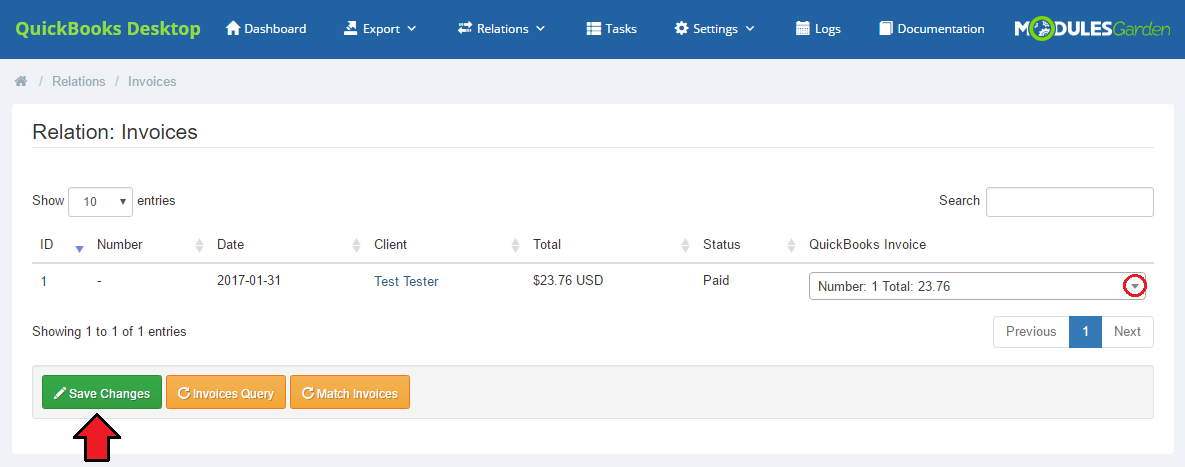
|
Cron Jobs
| Properly set up cron job with a recommended interval is responsible for importing and synchronization of data from QuickBooks into WHMCS e.g any updates done in invoices or clients' accounts from WHMCS. Once the cron is running, it executes settings included in 'Import Synchronization' table. |
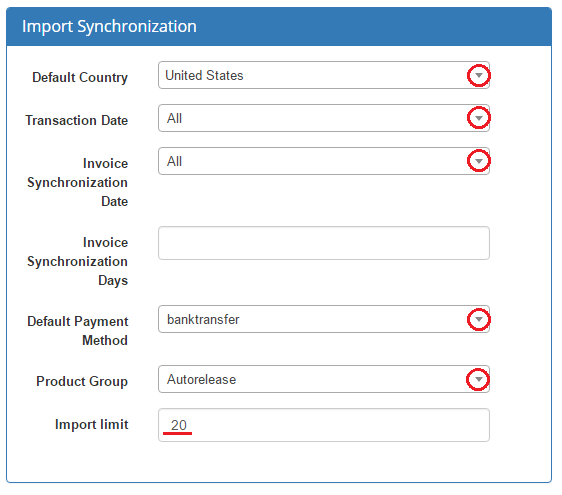
|
It is recommended to run cron job every six hours in order to synchronize the data between QuickBooks Desktop and WHMCS. |
Logs
| In 'Logs' tab there are enumerated ALL actions on clients, invoices and transactions. No matter if they were taken manually in the module, automatically or by a cron job. Find there a list of all entries with precisely described details and an exact date of the action. |
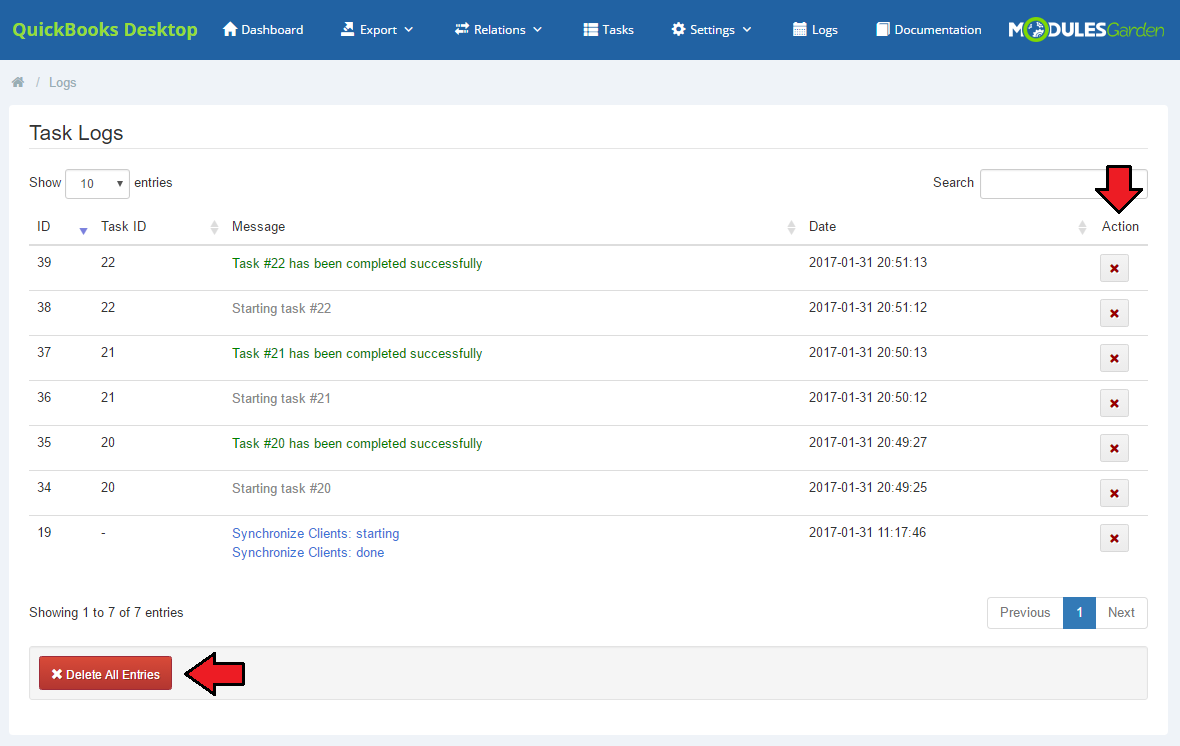
|
| Clear all the entries or delete only some of them. Use buttons marked on the screen above. |
Dashboard
| 'Dashboard' includes two useful and user-friendly tables. The first one, 'Export Summary' contains data on the number of exported clients, invoices and payments. |

|
Documentation
| The very last tab 'Documentation' once clicked will redirect you to the article you are currently reading! |
Tips
| 1. Please note that QuickBooks Desktop supports the services of One Time type only. Other billing cycles cannot be added. |
Common Problems
| 1. When you have problems with connection, check whether your SELinux or firewall does not block ports. |
| 2. It may happen that taxes are counted incorrectly for invoices with multiple items where part of the items is taxed and some are not. Please, be careful! |
| 3. In case you encounter any issues with installation and configuration please make sure you have php7.0-mcrypt and php7.0-soap installed.
Without that the module will not work properly. |
| 4. When .htaccess is enabled the module may not work due to the lack of connection between QuickBooks Web Connector and WHMCS system. |
| 5. In order for Web Connector to link with your WHMCS, your site has to be SSL cerified. |
|
6. If you get the following error: 'Got a packet bigger than 'max_allowed_packet' bytes' you need to increase SET GLOBAL max_allowed_packet=16777216; This command can be also perform in your phpMyAdmin if you are logged as root user. |
| 7. In case you see 'The given object ID "0" in the field "list id" is invalid.' error, please check that 'Default Products Item' or 'Domains Item' fields are properly configured. |